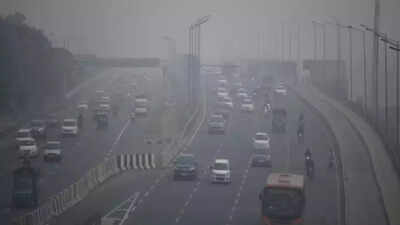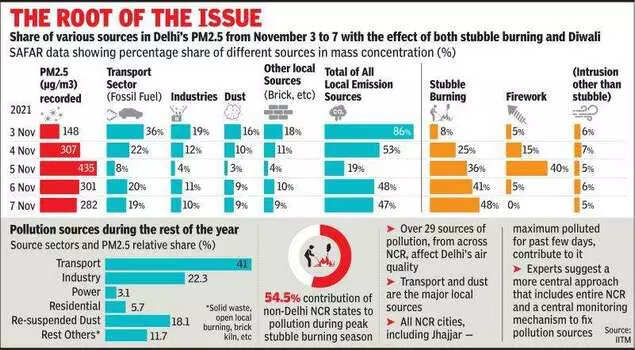Top Searches
- News
- City News
- delhi News
- Want a lasting solution? Tackle pollution sources in Delhi over the year
Want a lasting solution? Tackle pollution sources in Delhi over the year
Want a lasting solution? Tackle pollution sources in Delhi over the year

Image used for representational purpose only
NEW DELHI: Every year, confronting the pollution means inconvenience of all sorts — closing down school, stopping construction work, regulating industries, arguing about stubble burning and halting diesel generator use, etc. These are temporary measures. What must Delhi and neighbouring cities do year round to render the air breathable at all times?
The answer involves all the 29 sources of pollution, but at present, the pollution alleviation narrative is centred on just a few of them. Experts point out the loopholes in this approach, mainly related to inadequate public transport and end-mile connectivity, management of dust, construction and waste, outdated vehicular pollution monitoring system and the absence of a joint action plan.

Calling out the ‘very poor monitoring and enforcement mechanism’, Karthik Ganesan of Council on Energy, Environment and Water said, “Had there been a central monitoring and implementation system on pollution, then someone would have looked at IIT data to realise that emissions from Jhajjar in Haryana are abnormally high and sent a ground team to fix it. But there is no central approach.”
Track the pollution level in your city
Ganesan added that central agencies like CAQM had to build capacity and do more groundwork. He also argued against construction activity in the winter. “Just as mining work halts in the monsoon, why can’t construction be regulated in the winter months?” Ganesan asked.
According to Anumita Roy Chowdhury, executive director, Centre for Science and Environment, it was crucial to fix the city’s public transport system. She recommended an integrated transport system where buses and Delhi Metro shared a single payment mechanism. Pointing out that transport contributed at least 30% to the local emissions, she said, “Around 16% of Delhiites travel in personal cars and two-wheelers but occupy a major portion of the roads. The city needs 11,000 buses, but has only 6,000. The end-mile connectivity is also poor and cannot be relied upon.”
Chowdhury added, “There is also a need to update the pollution under control certification system because there are vehicles plying under different emission norms. PUC monitoring could be made remote sensed as in Kolkata.”
Experts said that a better system than water sprinkling in a water stressed city was needed to manage road dust. They suggested vegetation along the roads and large green covers like Aravalis and Ridge areas to act as natural barriers against dust. They also urged policies to decongest many city areas.
“We need policies to manage the pollution load of many areas by giving them time to breathe before they become polluted again,” said Professor Sewa Ram, School of Planning and Architecture. “Banning traffic from some areas on certain days, creating bypasses and imposing congestion cess like in London and New York are some ways to do this. But these presuppose a robust public transport system.”
To these, Dr S Velmurgan, chief scientist, CRRI, added, “The city needs better landscaping and dust-control mechanisms, especially use of dust covers at construction sites. There are no rules on how such covers should be installed and at what height.” He also pointed out that Delhi had 33,000km of road, of which only 1500km were dedicated footpaths and asked, “How will last-mile connectivity improve when there is no space to walk?”
Meanwhile, burning — be it coal, garbage, biomass or domestic fuels — is a major source of pollutants. Chandra Bhushan, CEO, iForest, described this as the elephant in the room. “The pollution situation is not going to improve until we address coal and biomass burning. Also cooking, heating, conventional fuels, garbage burning by unsensitised sanitation staff,” declared Bhushan. A policy is required to address this burning."
The answer involves all the 29 sources of pollution, but at present, the pollution alleviation narrative is centred on just a few of them. Experts point out the loopholes in this approach, mainly related to inadequate public transport and end-mile connectivity, management of dust, construction and waste, outdated vehicular pollution monitoring system and the absence of a joint action plan.

Calling out the ‘very poor monitoring and enforcement mechanism’, Karthik Ganesan of Council on Energy, Environment and Water said, “Had there been a central monitoring and implementation system on pollution, then someone would have looked at IIT data to realise that emissions from Jhajjar in Haryana are abnormally high and sent a ground team to fix it. But there is no central approach.”
Track the pollution level in your city
Ganesan added that central agencies like CAQM had to build capacity and do more groundwork. He also argued against construction activity in the winter. “Just as mining work halts in the monsoon, why can’t construction be regulated in the winter months?” Ganesan asked.
According to Anumita Roy Chowdhury, executive director, Centre for Science and Environment, it was crucial to fix the city’s public transport system. She recommended an integrated transport system where buses and Delhi Metro shared a single payment mechanism. Pointing out that transport contributed at least 30% to the local emissions, she said, “Around 16% of Delhiites travel in personal cars and two-wheelers but occupy a major portion of the roads. The city needs 11,000 buses, but has only 6,000. The end-mile connectivity is also poor and cannot be relied upon.”
Chowdhury added, “There is also a need to update the pollution under control certification system because there are vehicles plying under different emission norms. PUC monitoring could be made remote sensed as in Kolkata.”
Experts said that a better system than water sprinkling in a water stressed city was needed to manage road dust. They suggested vegetation along the roads and large green covers like Aravalis and Ridge areas to act as natural barriers against dust. They also urged policies to decongest many city areas.
“We need policies to manage the pollution load of many areas by giving them time to breathe before they become polluted again,” said Professor Sewa Ram, School of Planning and Architecture. “Banning traffic from some areas on certain days, creating bypasses and imposing congestion cess like in London and New York are some ways to do this. But these presuppose a robust public transport system.”
To these, Dr S Velmurgan, chief scientist, CRRI, added, “The city needs better landscaping and dust-control mechanisms, especially use of dust covers at construction sites. There are no rules on how such covers should be installed and at what height.” He also pointed out that Delhi had 33,000km of road, of which only 1500km were dedicated footpaths and asked, “How will last-mile connectivity improve when there is no space to walk?”
Meanwhile, burning — be it coal, garbage, biomass or domestic fuels — is a major source of pollutants. Chandra Bhushan, CEO, iForest, described this as the elephant in the room. “The pollution situation is not going to improve until we address coal and biomass burning. Also cooking, heating, conventional fuels, garbage burning by unsensitised sanitation staff,” declared Bhushan. A policy is required to address this burning."
FacebookTwitterLinkedinEMail
Start a Conversation
end of article

